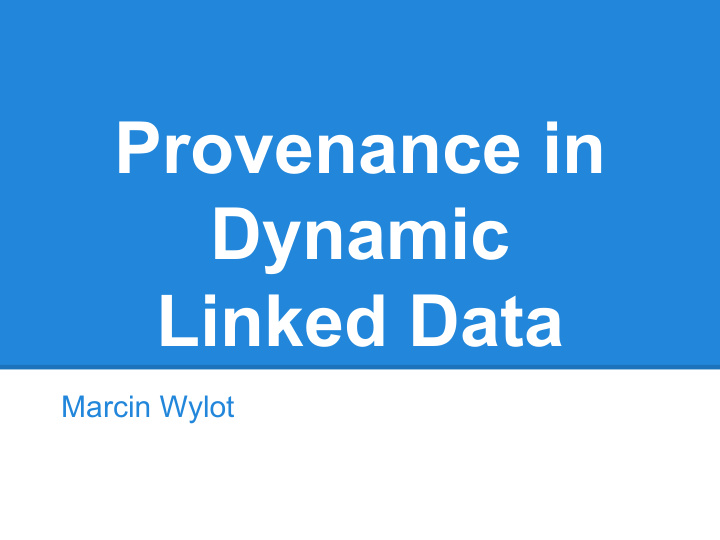



Provenance in Dynamic Linked Data Marcin Wylot
Linking Everything: Dynamic Graphs ➢ Integrated and summarized uncertain graph data ➢ Dynamic physical and logical network of “things” ➢ Necessity to established transparency 2
Data Provenance “Provenance is information about entities, activities, and people involved in producing a piece of data or thing, which can be used to form assessments about its quality, reliability or trustworthiness.” What pieces of data and how they were combined to produce the results? 3
Outline ➢ Storing and tracking provenance in Linked Data [DONE] ➢ Restricting query execution with provenance data [DONE] ➢ Provenance in dynamic data [FUTUR] ➢ Provenance for performance [FUTUR] 4
How to store and track provenance in Linked Data processing? ➢ a new way to express the provenance of query results at two different granularity levels by leveraging the concept of provenance polynomials ➢ two new storage models to represent provenance data in a native RDF data store compactly ➢ query execution strategies to derive the provenance polynomials while executing the queries Wylot, Marcin, Philippe Cudre-Mauroux, and Paul Groth. "Tripleprov: Efficient processing of lineage queries in a native RDF store." Proceedings of the 23rd international conference on World wide web. ACM, 2014. 5
Provenance Polynomials "Algebraic structures for capturing the provenance of sparql queries." Geerts, Floris, et al. Proceedings of the 16th International Conference on Database Theory. ACM, 2013. ➢ Ability to characterize ways each source contributed ➢ Pinpoint the exact source to each result ➢ Trace back the list of sources the way they were combined to deliver a result 6
Polynomials Operators ➢ Union ( ⊕ ) ○ constraint or projection satisfied with multiple sources l1 ⊕ l2 ⊕ l3 ○ multiple entities satisfy a set of constraints or projections ➢ Join ( ⊗ ) ○ sources joined to handle a constraint or a projection ○ OS and OO joins between few sets of constraints (l1 ⊕ l2) ⊗ (l3 ⊕ l4) 7
Example Polynomial select ?lat ?long where { ?a ?p “Eiffel Tower”. ?a inCountry FR . ?a lat ?lat . ?a long ?long . } (l1 ⊕ l2 ⊕ l3) ⊗ (l4 ⊕ l5) ⊗ ( l6 ⊕ l7) ⊗ (l8 ⊕ l9) 8
How can we efficiently support queries tailored with provenance information? ➢ a characterization of provenance-enabled queries (RDF queries tailored with provenance data) ➢ storage model and indexing techniques extensions to handle provenance-aware query execution strategies ➢ five provenance-oriented query execution strategies Wylot, Marcin, Philippe Cudre-Mauroux, and Paul Groth. "Executing provenance- enabled queries over web data." Proceedings of the 24th International Conference on World Wide Web. ACM, 2015. 9
Provenance-Enabled Query A Workload Query is a query producing results a user is interested in. These results are referred to as workload query results. A Provenance Query is a query that selects a set of data from which the workload query results should originate. A Provenance-Enabled Query is a pair consisting of a Workload Query and a Provenance Query , producing results a user is interested in (as specified by the Workload Query) and originating only from data pre-selected by the Provenance Query. 10
Provenance-Enabled Query: Example SELECT ?title WHERE { ?a <type> <article> . ?a <tag> <Obama> . ?a <title> ?title . } ➢ ensure that the articles come from sources attributed to the government SELECT ?ctx WHERE { ?ctx prov:wasAttributedTo <government> . } ➢ ensure that the data used to produce the answer was associated a “ SeniorEditor ” and a “Manager” SELECT ?ctx WHERE { ?ctx prov:wasGeneratedBy <articleProd>. <articleProd> prov:wasAssociatedWith ?ed . ?ed rdf:type <SeniorEdior> . <articleProd> prov:wasAssociatedWith ?m . ?m rdf:type <Manager> . } 11
TripleProv: Query Execution Pipeline 12
Lessons Learnt • Provenance overhead does not have to be high. • We can leverage provenance information to improve performance. 13
Dynamic Linked Data ➢ Velocity ➢ Dynamic structure of the graph ➢ Incompleate data ➢ Heterogenous environment 14
Continuous Provenance Polynomial 1. It has to be computed efficiently in a continuous fashion along with the execution of the query. 2. It has to take into account the missing and recovered pieces of the data. 3. It has to show how the query execution process evolves over time. 15
Provenance for Performance ➢ Heavy analytics ➢ Hypothetical queries ➢ Reasoning 16
Take Home Message Provenance can be traced in an efficient way and can be leveraged to improve proformance of query execution. 17
Recommend
More recommend